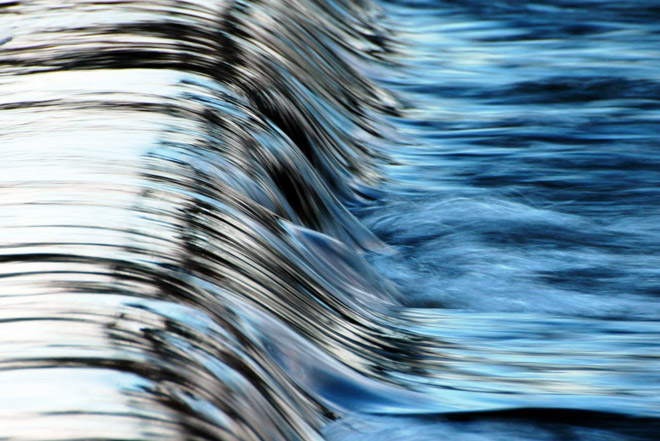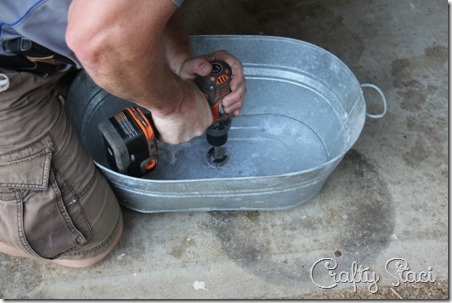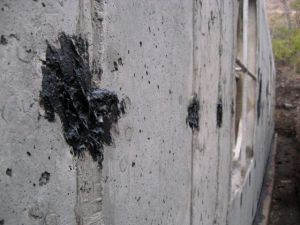Shiur 6 – 2/13/19
1- We learned the Halacha of a כלי that is connected to a מעין.

Generally, a מעין, has the properties to be מטהר, all types of waters. Such as drawn water שאובין. However, a מעין cannot change the issue of a כלי.
The Torah says מעין ובור. That excludes any type of כלי.
2- It follows, that a spring of water, despite it flowing from a well a מעין, when it fills a large tub or tank, it does not create a kosher מקוה. The issue is the structure of the מקוה, in this case a כלי. So because the water is in this tub, despite being connected to the steam, it does not negate the fact that it is a כלי, and a כלי cannot be used as a Mikvah, and therefore the water becomes שאובין.

3- Now, the overflow of this כלי, is also problematic. Because once the water enters this tank it is considered שאובין and the overflow is obviously שאובין.
4- However, if some of this stream’s water never enters the tank and it mixes with the overflow then the water of the מעין, will ‘purify’ the rest of the שאובין overflow.

Here is the text we learnt.
סעיף ח
Preface:
Mishna, Mikvous Chapter 5, 1
מַעְיָן שֶׁהֶעֱבִירוֹ עַל גַּבֵּי הַשֹּׁקֶת, פָּסוּל. הֶעֱבִירוֹ עַל גַּבֵּי שָׂפָה כָל שֶׁהוּא, כָּשֵׁר חוּצָה לָהּ, שֶׁהַמַּעְיָן מְטַהֵר בְּכָל שֶׁהוּ
Regarding a spring that was led to pass over a man-made trough, the mikveh filled from its waters is invalid. Because it was from a vessel (the trough) and considered drawn.
If any even minimal amount of water was led to pass over its edge, it is valid for immersion outside of it, anywhere outside of the trough, and even on its edge. Since a spring purifies even with a minimal amount.
Mechaber
מעיין שמקלח לתוך כלי, פסול לטבול בין במים שבתוך הכלי בין לאחר שיצאו מהכלי – A spring that trickles into a vessel, is invalid to immerse in. Whether in the water that’s in the vessel or in the water that comes out of the vessel. Because it was from a vessel and considered drawn.
ואם המעין מקלח על שפת הכלי ולתוכו, תוך הכלי אסור לטבול; וחוצה לו, מותר, אפילו אם המים שבתוכו מרובין – However, if the spring leaks onto the edge of the vessel and into it, one may not immerse inside the vessel; but outside of it, it is allowed to immerse in. Since a spring purifies even with a minimal amount less than 40 Seah, even if the water inside is more than the water outside of the trough.
——
ש”ך
מעיין כו כ״ו:
פי’ דאם מעיין מקלח לתוך הכלי (אפי’ הוא תלוש – Meaning, that if the spring trickles into the vessel (even if it’s disconnected) ויוצאים לחוץ ממנו פסולים לטבול בהן – And then proceeds to go out of the vessel it’s invalid to immerse in this water.
דמה שבתוך הכלי פשיטא פסול – For what is inside the vessel is most obviously invalid as it
is drawn water ומה שלחוץ נמי פסול דמיד שעברו בכלי נעשו שאובים – And for the water which went out of the vessel is also invalid. For as soon as it passes through the vessel it immediately becomes drawn water and is thus invalid water for immersion.
וכתב הב”ח סעיף י”ג דל”ש כשהכלי שלם בלא שום נקב והמעיין מקלח לתוך הכלי וכשנתמלא הכלי יוצאים אח”כ מפה הכלי ולחוץ – The Bac”H writes in seif 13 – That it makes no difference whether the vessel is complete without any holes, thus the spring trickles inside the vessel, and when the vessel fills to the top it overflows and exits from the mouth of the vessel
ל”ש שיש נקב בצדו של כלי וממנו מקלחים לחוץ נקראו מים שאובים – Or whether there is a hole in the side of the vessel and from there that hole it leaks outside. In both instances, the water is considered drawn. דלא נתבטל שם כלי מחמת הנקב שמצדו כיון שמקבל מים מן הנקב ולמטה – For it does not lose its status as a vessel because of such a hole. Since it can hold water below the hole. Thus, if the hole is high enough to have room to hold water below it, it’s still considered a vessel. And now that its status is established as a vessel, it will invalidate any water that enters it – as drawn water. אבל נקב בשולי הכלי כשפופרת הנאד אז ודאי דנתבטל שם כלי ושרי לטבול אף בתוך הכלי כמו שנתבאר במקוה דבדבר זה שוה מעיין ומקוה עכ”ל ופשוט הוא – However, a hole in the bottom of the vessel as wide as a vat spout, thus it cannot hold any water. It most definitely loses its status as a vessel. Hence, one may immerse inside this water and even inside this vessel. As explained earlier that in a case of a vessel a spring and mikvah are similar regarding their laws. And this is obvious.
כ״ז: ואם המעיין כו
פי’ רוב המעיין עובר לתוך הכלי וקצתו עובר ומקלח אצל שפת הכלי – Meaning, that most of the water goes through the vessel, and only some of the water passes and trickles on the rim of the vessel, however that small amount on the rim, never enters the vessel. And thus – כיון שמעט מימי המעיין לא עברו תוך הכלי כלל – Because this small amount of water did not become invalid. As it did not at all pass through the vessel הן מעלין את המים המרובים ומטהרין את השאובים ואע”פ שחוזרים ומתערבים כולם יש להם דין מעיין – They, this water, that did not enter the vessel, and is thus not considered drawn water. They purify the majority of the invalid drawn water inside the vessel and make the drawn water valid for immersion. Although they nonetheless all mix together, they are now valid immersion water and are considered mayan water.
(ועיין ב”י מ”ש לדעת רשב”א וכבר מחו ליה אמוחא הר”ר יוסף טייצאק והב”ח אך מ”ש הב”ח על הב”י והחזיק דבריו מלשון תשובת הרשב”א כו’ ועובר על גביו ולחוץ טובלין וכמו ששנינו כו’ ותימה גדולה כו’ שגגה יצאה מלפניו דתיבת ולחוץ נמשך לתיבת טובלים והוא כדעת בית יוסף דלא כב”ח שהבין דולחוץ נמשך למעלה ולכן טרח בחנם להגיה בדברי הרשב”א וזה ברור ואין צורך להאריך כאן בדברי’ אלו כיון שלענין הדין המחבר גופיה פסק דבעינן מקלח על שפת הכלי וק”ל)
וכתב הב”ח מיהו מה שמתיר הרשב”א לטבול תוך הכלי כשיש מ’ סאה ביניהם – The Bac”h writes : that this that the Rashb”a allows one to immerse inside a vessel that is connected to a spring of valid immersion water when there are 40 seah between them. For the reason of
“ עירוב מקוואות – mixing”. i.e. Since the vessel is inside the water, and there is both water inside the vessel on its outer edges. Thus, the water on its outer edges mixes with the water inside the vessel and validates them as they are now mixed and attached. However, this would only be in a case where the vessel carries 40 seah, for if not the Mishnah clearly states that this would make it invalid. דין חדש הוא ולא משמע הכי מהפוסקים – This is a “new law” and it does not seem this way from the Halachic authorities אלא תוך הכלי לעולם פסול אם לא ניקב בשוליו אפי’ יש מ’ סאה בין המעיין לכלי – Rather, immersing inside the vessel is always invalid. Unless it has a hole, which would remove its status as a vessel. Even if there are 40 seah between both the spring and vessel וגם מלשון הרא”ש גופיה נראה דלא פסיק ליה האי דינא ע”כ – And it would seem that even the Ros”h himself did not hold like this law.
כתב הב”י בשם המרדכי בשם רבי יואל ובשם הרוקח – The B”Y writes in the name of the Mordechai in the name of Reb Yoel and The Rokeach
דאמת המים שהמשיכוה דרך חריץ בקרקע אל גיגית גדולה – An aquatic aqueduct that was cut as a trench in the ground to a large tub
מחזקת יותר ממ’ סאה – Which can hold more than 40 seah
ושקע הגיגית בקרקע אסור לטבול בתוך הגיגית כו’ אע”פ שמי הגיגית שהן שאובין מחוברים אל האמה ע”כ – And the tub was attached to the ground, it is invalid to immerse inside the tub
ופשוט הוא דאם יש בשולי הגיגית נקב כשפופרת הנוד דכשר – And it is obvious that if there is a hole on the bottom of the tub the size of a bladder spout it would be valid for immersion:
——
ט”ז
על שפת הכלי ולתוכו.
פי’ שהיו מי המעיין נופלים מקצתן ע”ג שפת הכלי ומקצתן לתוך הכלי כשרים המים היוצאי’ מן הכלי – Meaning, there was some water on the edge of the vessel, and some water inside the vessel. The water exiting the vessel is Kosher for immersion אע”פ שאסור להטביל בתוכו – Although one is not allowed to immerse inside the vessel itself
לפי שהמעיין שנופל על שפת הכלי מטהר כל המים בכל שהוא – Since the water that falls on the edge of the vessel, so to say purifies all of the water. Even if it’s a minute amount אע”פ שמי הכלי הם מרובים – Although, ostensible this should not be the case, as most of the water is inside the vessel. And this water is “drawn water”.
. מ”מ כל המים הם מחוברים למעיין ע”י המים המעוטים הנופלי’ על שפת הכלי ונטהרים – Nonetheless, all of the water, even the water inside the vessel, are now attached to the spring, by being attached to the minimal water that fell on the edge and they are thus purified.
אע”פ שכבר נפסלו בשאיבה כשעברו דרך הכלי – Even though, at one point, they were invalid as drawn water when they went through the vessel .כ”כ הרא”ש ועי’ מ”ש בסעיף ב’ דל”ת מכאן על התם.









